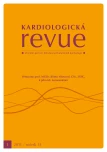The importance of heart rate modulation in patients with cardiac failure
Authors:
J. Hradec
Published in:
Kardiol Rev Int Med 2011, 13(1): 24-29
Category:
From Hypertension to Heart Failure
Overview
Tachycardia is one of the symptoms of heart failure and, in contrast to a healthy myocardium, lowers the heart’s efficiency and performance. There is sufficient convincing evidence of the fact that, similarly to other cardiovascular diseases, an increasing heart rate (HR) is a predictor of a bad prognosis in chronic heart failure. The slowing of the HR through beta blockers significantly improves the prognosis of patients with chronic heart failure, as proven in several large clinical studies. It is assumed that the chief mechanism leading to improved prognoses is the slowing of the HR. Beta blockers have, moreover, a number of other effects that could influence the prognosis of patients with heart failure, either positively or negatively. The blocker of the If channel ivabradine is a substance that selectively lowers the HR without having any other haemodynamic or electrophysiological effects. Ivabradine thus allows the study of the effects of lowered HR per se. The BEAUTIFUL study of patients with ischemic heart disease and systolic dysfunction of the left ventricle or heart failure showed a positive development in cardiovascular incidents only in patients with a resting HR of ≥ 70 min-1. The subsequent SHIFT study, which included patients with heart failure and HR ≥ 70 min-1, showed a significant reduction in the number of hospitalisations and deaths from heart failure. The placebo component of both studies then provided convincing evidence that HR is a strong, independent predictor of the cardiovascular prognosis. The SHIFT study then showed that the reduction in the incidence of the primary monitored endpoint was greater, the lower HR was achieved through ivabradine therapy. It seems therefore that HR is not only a predictor of risk, but also a real cardiovascular risk factor, pharmacological intervention of which can improve the prognosis. It seems that pharmacological modulation is useful with HR ≥ 70 min-1, with an optimal target value of around 60 min-1.
Keywords:
ivabradine – cardiovascular prognosis – heart rate – heart failure
Sources
1. Böhm M, La Rosee K, Schmidt U et al. Force-frequency relationship and inotropic stimulation in the non-failing and failing human myocardium: implication for the medical treatment of heart failure. Clin Investig 1992; 70: 421–425.
2. Lechat P, Escolano S, Golmard JL et al. Prognostic value of bisoprolol-induced hemodynamic effects in heart failure during the Cardiac Insufficiency Bisoprolol Study (CIBIS). Circulation 1997; 96: 2197–2205.
3. Lechat P, Hulot LS, Escolano S et al. Heart rate and cardiac rhythm relationship with bisoprolol benefit in chronic heart failure in CIBIS II trial. Circulation 2001; 103 : 1428–1433.
4. Metra M, Torp-Pedersen C, Swedberg K et al. Influence of heart rate, blood presssure, and beta-blocker dose on outcome and the difference in outcome between carvedilol and metoprolol tartarate in patients with chronic heart failure: results from the COMET trial. Eur Heart J 2005; 26 : 2259–2268.
5. Gullestad L, Wikstrand J, Deedwania P et al. MERIT-HF Study Group. What resting heart rate should one aim for when treating patients with heart failure with a beta-blocker? Experiences from the Metoprolol Controlled Release/Extended Release Randomized Intervention Trial in Chronic Heart Failure (MERIT-HF). J Am Coll Cardiol 2005; 45 : 252–259.
6. Kjekshus J, Gullestad L. Heart rate as a therapeutic target in heart failure. Eur Heart J 1999; 1 Suppl: H64–H69.
7. Kendall MJ, Lynch KP, Hjalmarson A, Kjekshus J. Beta-blockers and sudden cardiac death. Ann Intern Med 1995; 123 : 358–367.
8. Hradec J. Selektivní ovlivnění srdeční frekvence – nový fenomén v kardiovaskulární farmakoterapii. Remedia 2008; 18 : 114–119.
9. Borer JS, Fox K, Jaillon P, Lerebours G. Ivabradine Investigators Group. Antianginal and antiischemic effects of ivabradine, an I(f) inhibitor, in stable angina: randomized, double-blind, multicentered, placebo-controlled trial. Circulation 2003; 107 : 817–823.
10. Fox K, Ford I, Steg G et al. BEAUTIFUL investigators. Heart rate as a prognostic risk factor in patients with coronary artery disease and left-ventricular systolic dysfunction (BEAUTIFUL): a subgroup analysis of a randomised controlled trial. Lancet 2008; 372: 817–821.
11. Fox K, Ford I, Steg G et al. BEAUTIFUL investigators. Ivabradine for patients with stable coronary artery disease and left-ventricular systolic dysfunction (BEAUTIFUL): a randomised, double-blind, placebo--controlled trial. Lancet 2008; 372 : 807–816.
12. Swedberg K, Komajda M, Böhm M et al. SHIFT investigators. Ivabradine outcomes in chronic heart silure (SHIFT): a randomised placebo-controlled study. Lancet 2010; 376 : 875–885.
13. Böhm M, Swedberg K, Komajda M et al. SHIFT investigators. Heart rate as a risk factor in chronic heart failure (SHIFT): the association between heart rate and outcomes in a randomised placebo-controlled trial. Lancet 2010; 376 : 886–894.
14. Bucchi A, Baruscotti M, DiFrancesco D. Current-dependent block of rabbit sino-atrial node I(f) channels by ivabradine. J Gen Physiol 2002; 120: 1–13.
Labels
Paediatric cardiology Internal medicine Cardiac surgery CardiologyArticle was published in
Cardiology Review

2011 Issue 1
Most read in this issue
- Cardiogenic shock
- Is the prognosis of congestive heart failure patients still so bad?
- Mechanical ventricular support devices in heart failure treatment
- Latent obstruction in outflow tract of left ventricle in patient with hypertrophic cardiomyopathy
